Chinese Marriage Charms

Background and History
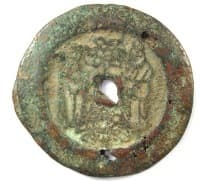
The choice of a marriage partner was the responsibility of the parents and social status and wealth were the primary determinants. Romantic love was not a factor. In fact, child betrothals (engagements) were common and many young people, upon reaching a marriageable age, may have never met their future spouse until the day of the wedding.
Symbolism in Traditional Chinese Weddings and Marriages
Just as in the other facets of ancient Chinese life, many of the customs and rituals concerning the marriage proposal, presenting the betrothal and wedding gifts to the bride's parents, sending the bride's dowry to the future groom's family, and the wedding ceremony itself, involved the use of traditional wedding and marriage symbols.
For example, the traditional dowry would include scissors shaped like two butterflies which symbolize joy and warmth and being inseparable, vases which symbolize peace, and rulers which symbolize large fields for farming.
The dowry would have included a chamber pot filled with various fruits (symbolizing fertility) and coins (symbolizing wealth and prosperity).
The bridal bed was installed on the day before the wedding by a person with "good luck" (i.e. having many children). Auspicious symbols such as dates (meaning "soon"), peanuts (meaning "give birth"), chestnuts ("establish sons"), pomegranates (fertility), lotus seeds ("continuous births"), bran ("rich son"), and other fruits were scattered on the bridal bed.
Children were then allowed to play on the bed and grab the treats
(Please see Hidden Meaning of Chinese Charms for specifics on the above symbols.)
The bride's hair was styled in the glow of "dragon and phoenix" candles representing the union of a man and a woman, and she would wear a red silk veil under a phoenix bridal crown.
The groom would wear a cap decorated with cypress leaves symbolizing the wish for "many" such as children, money, etc.
The procession from the groom's home to obtain the bride was accompanied by a dancing lion or Chinese unicorn (qilin 麒麟) symbolizing good luck, prosperity, goodwill and benevolence. At the bride's home the groom would receive a pair of chopsticks which had the hidden meaning of "having sons quickly".
On the bride's journey to the groom's home, fertility symbols of rice and grain were scattered before the procession. A traditional Chinese bronze mirror would be attached to the rear of the sedan chair or to the bride's garments to protect her from evil spirits.
A bronze mirror (tongjing 铜镜) and a pair of shoes (xie 鞋) were also a traditional marriage gift because the words combined formed the auspicious meaning of "together and in harmony" (tongxie 同谐).
Upon crossing the threshold of the groom's home, the bride would step over a "saddle" (an 鞍) which in Chinese has the same pronunciation as the word for "peace" (an 安).
At the wedding ceremony, the bride and groom would seal their marriage vows by drinking wine and honey from two cups tied together by a red cord. This reflected the belief that the "God of Marriage", also known as the "Old Man of the Moon" (yue lao 月老, jie lin 结琳, or yue xia lao ren 月下老人), used an invisible red silk thread to tie together the feet of couples destined to be married.
For more detailed explanations of any the symbols mentioned above, please see The Hidden or Implied Meaning of Chinese Charm Symbols.
Sex Education
While sex education was not a topic freely discussed in ancient China, it was nevertheless important for newlyweds to have a basic understanding of what they should do on their wedding night in order to fulfill their obligation to family and society to have sons.
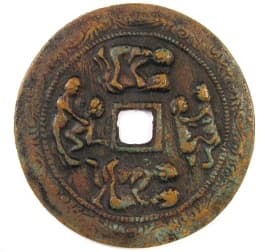
four sexual positions
These marriage coins or charms usually had an innocuous inscription (legend) such as "Wind, Flowers, Snow, Moon" on one side. The reverse side of the coin would depict one, two, or four couples making love in various sexual positions as can be seen on the coin at the left.
The Chinese usually refer to these coins as mixiqian (秘戏钱) which means "secret play" or "secret fun" coins. They are also known as bi huo qian (避火钱) which means "hide (evade) the fire (of lust) coins". In English, they are variously referred to as Chinese marriage coins, Chinese love coins, Chinese spring money, Chinese erotic coins, Chinese wedding coins, etc.
As mentioned, these coins are sometimes called "spring" (chun 春) money. This refers to the ancient Chinese springtime ritual, still practiced today by some ethnic minorities, where boys and girls separated by a stream would sing love songs to each other.
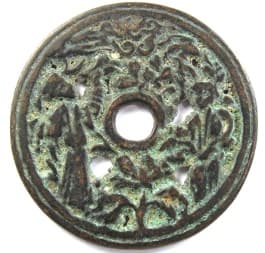
young couple discussing love
The scene refers to the old Chinese saying hua qian yue xia (花前月下) which means "in front of the flowers and under the moon".
A young man on the left is pointing at the moon which is the "u"-shaped crescent surrounded by clouds just below the rim at the very top of the charm.
A young woman is at the right. Flowers are above and below the circular hole.
This charm is said to have originated in Yunnan Province which is home to many Chinese ethnic minorities.
The use of the inscription "Wind, Flowers, Snow, Moon" is also consistent with the Chinese esthetic preference to not simply emphasize the sexual act itself. Classical Chinese art likes to also convey the beauty, harmony and natural setting of the action.
It is said that these coins also had another purpose. In addition to being titillating, they were apparently used in brothels where a shy patron, or one not conversant in the local Chinese dialect, could communicate his wishes by simply pointing to the desired sexual activity on the coin.
History of Sex Images in Chinese Art
Throughout most of China's long history, the pictorial display of human sexual activity was rarely openly displayed.
Nevertheless, there are pictures depicting men and women engaged in sexual acts on stone carvings dating from the Han Dynasty (206 BC - 220 AD), and the theme was also fairly popular on the bronze mirrors of the Tang Dynasty (618-907 AD).
The graphic depiction of the sex act did not start to appear on Chinese coins and charms until the early Tang and it then continued through the Song (960-1279 AD) and following dynasties.
Meaning of "Wind, Flowers, Snow, Moon"
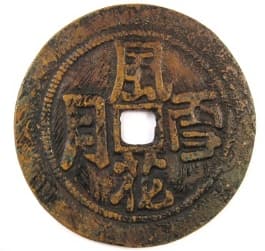
"wind, flowers, snow and moon"
However, the most plausible explanation for the use of this expression is that each of the words (wind, flowers, snow, moon) may represent a Chinese goddess.
For example, there is a well-know four-volume Chinese erotic novel from the late Ming dynasty (ca. 1640 AD) entitled Su E Pian (素娥篇). The story describes the romantic adventures of Wu San Si (武三思) and a beautiful concubine by the name of Su E (素娥). Su E is sometimes referred to as the "Lady of the Moon". The couple is inspired to make love in a variety of natural settings using forty-three different sexual positions. Illustrated wood engravings accompany the text.
The inscription may also be referring to the "Seven Fairy Maidens" (qi xian nu 七仙女). For example, there is the famous Han Dynasty story of Dong Yong who sold himself into bondage as an indentured servant so that he could earn enough money to properly bury his father. Dong Yong met a pretty women who miraculously helped him repay his debt in a very short time and thus freed him from servitude. The "pretty women" was in fact the youngest daughter, and one of the Seven Fairy Maidens, of the legendary Jade Emperor. For a more on this and to see a charm related to the story please see Confucian Charms.
There are other inscriptions sometimes seen on wedding coins of this type such as feng hua yi ren (风花宜人) which translates as "wind and flowers delight men". It is also interesting to note that, in ancient times, yi ren (宜人) was a title given to the wives of officials of the fifth degree. I am unsure if there is any hidden meaning in this context.
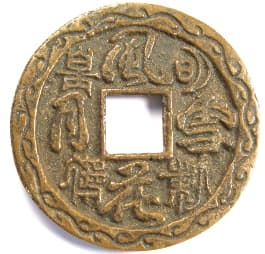
referring to Emperor Xuanzong and
Yang Guifei
The first inscription, written in large characters (top, bottom, right, left), is the familiar feng hua xue yue (风花雪月) meaning "wind, flowers, snow and moon".
The second inscription is written in smaller seal script characters and is read in a different order. Beginning at the upper right corner of the square hole and reading counterclockwise, the inscription is ming huang yu ying (明皇御影) which translates as "Emperor Ming imperial shadow".
The ming huang (明皇), in this case, refers to Emperor Xuanzong (685-762 AD), also known as Emperor Ming, of the Tang Dynasty. Emperor Xuanzong's concubine Yang Guifei (杨贵妃) was considered one of the Four Beauties of ancient China.
Dragon and Phoenix Symbols
The most prominent of all Chinese marriage symbols is the pairing of a dragon (long 龙) and a phoenix (feng 凤) which represents love and a happy marriage.
The dragon is the preeminent male or yang (阳) symbol and represents strength and the warmth of the sun.
The phoenix, as you might expect, is the ultimate female or yin (阴) symbol.
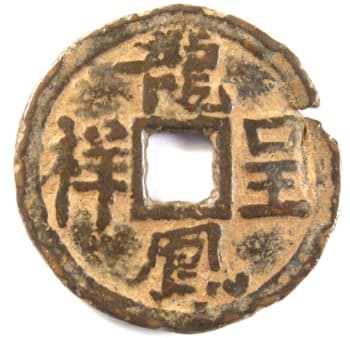
"long feng cheng xiang"
The inscription on this old charm is long feng cheng xiang (龙凤呈样) which is a common expression used to congratulate newlyweds on their marriage.
Long feng cheng xiang can be variously translated as "the dragon and phoenix become a good omen", "prosperity brought by the dragon and phoenix", and "may you have excellent good fortune".

charm showing a dragon and phoenix
The reverse side of the charm depicts a dragon on the right and a phoenix on the left.
This charm has a diameter of 30 mm and a weight of 5.4 grams.
The dragon and phoenix symbols are very frequently seen on Chinese marriage charms and several other examples are displayed below.
New Wedding Tradition
Many of the old marriage traditions discussed above are now followed only in the more conservative areas of the country.
In Chinese cities, however, there has developed a new "tradition" which is to drink the soft drink "7 Up" at weddings. The reason is that the Chinese word for "7 Up" is qixi (七喜) which means "7 happinesses"!
Chinese Marriage Charms
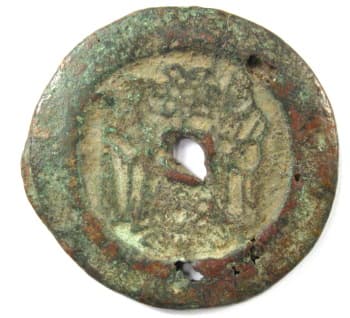
There is no inscription or Chinese characters on this bronze charm with a beautiful patina.
The charm itself is large and heavy but fairly crudely made. It is not perfectly round, the metal has holes, and the square hole in the center is not well made. The rim is very wide.
However, the drawing of the figures and other objects in the scene are fairly well done.
Both above and below the center square hole are lotus. The Chinese word for lotus is hehua (荷花). The first character he (荷) has the same pronunciation as the words for "to join" (he 合) and "harmony" or "peace" (he 和). The hidden meaning of the lotus is therefore the wish that the couple will come together in harmony.
But, there is a further play on words because another word for lotus is lianhua (莲花). The first character lian (莲) has the same pronunciation as the word for "to connect" or "continuous" (lian 连) and thus the symbolic meaning of being together forever is further strengthened.
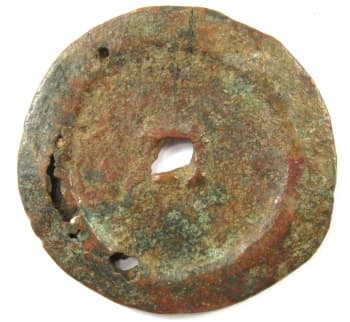
marriage charm
The reverse side of the charm is plain with no inscription or symbols.
The charm has a diameter of 56 mm at its widest part.
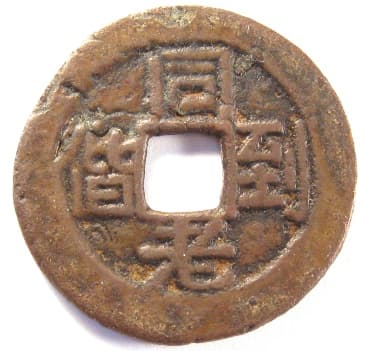
meaning "May you grow old together"
(tong xie dao lao)
(obverse side)
This marriage charm expresses the wish that the couple will live a long and prosperous life together.
There are inscriptions on both sides which are read in an unusual manner: top, left, right, bottom.
The inscription on this side of the charm is tong xie dao lao (同偕到老) which means "May you grow old together (as husband and wife)".
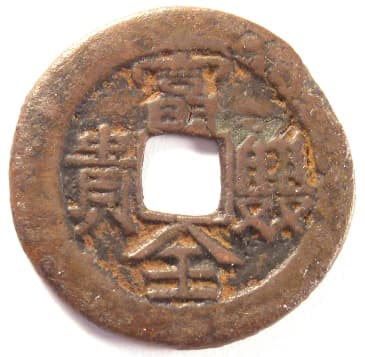
"Wealth and honor both complete"
(fu gui shuang quan)
(reverse side)
The inscription on this side of the charm is fu gui shuang quan (富贵双全) which translates as "Wealth and honor both complete".
This charm has a diameter of 25.7 mm and a weight of 4.2 grams.
Dragon and Phoenix Marriage Charms
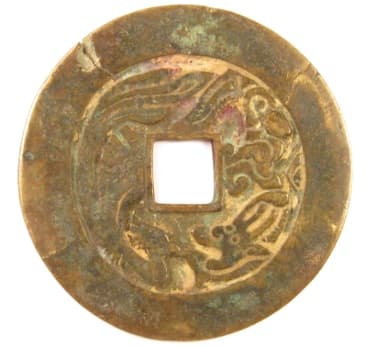
dragon and phoenix on reverse
As explained above, the dragon and phoenix paired together represent the ultimate union of a man and a woman.
The charm at the left displays a beautiful phoenix to the left of the center hole and a wide-eyed dragon on the right. The two are facing each other with their heads at the bottom of the charm.
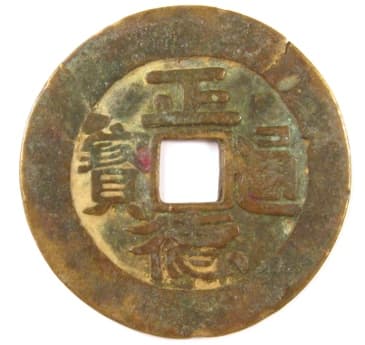
This is the obverse side of the charm. The inscription is zheng de tong bao (正德通宝).
This is a popular legend for charms because zheng de has the auspicious meaning of "correct virtue" in Chinese which is an appropriate wish for a newlywed couple.
Additional details concerning this charm can be found at Chinese Charms with Coin Inscriptions.
The charm has a diameter of 45 mm and weighs 14.5 grams.
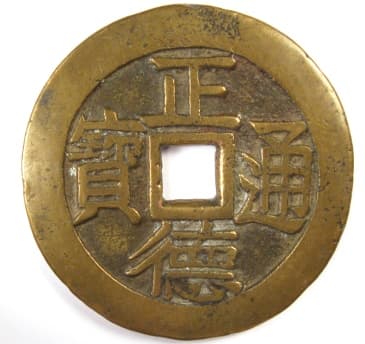
inscription "Zheng De Tong Bao"
This is another excellent example of a zheng de tong bao (正德通宝) marriage charm.
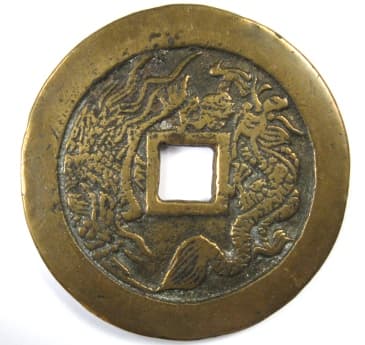
charm with a dragon and phoenix
The reverse side of the charm has a very detailed dragon and phoenix symbolizing the marriage couple.
The dragon is on the right with its head at approximately the two o'clock position.
The phoenix is on the left with its head at the eight o'clock position.
This is a very well made charm. It is large and heavy.
The diameter is 54 mm and the weight is 42.3 grams.
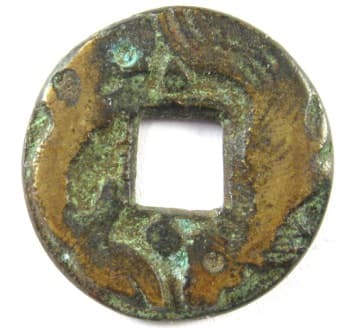
with a dragon and phoenix
(reverse side)
The reverse side of this old marriage charm has the dragon on the left and the phoenix on the right.
The two are facing each other with their heads at the bottom of the charm.
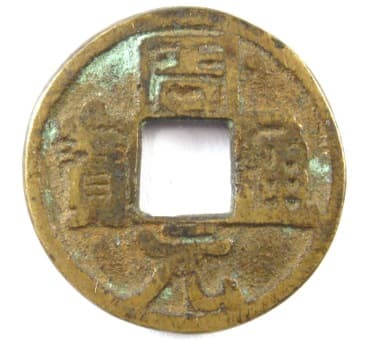
(obverse side)
The inscription is the same as that found on coins cast during the reign of Emperor Shi Zong of the Later Zhou Dynasty (951 - 960 AD).
Although this charm is from a later period, charms with this inscription are very popular. Beginning in the year 956, Emperor Shi Zong ordered that the bronze Buddha statues in the Buddhist temples, as well as the bronze items owned by the people, be turned in to the government so that they can be melted down and used to cast coins. As a result, coins with this inscription are considered especially auspicious because they contain metal from Buddhist statues. This belief has carried over to charms and amulets displaying the same inscription.
The diameter of the charm is 22.5 mm and the weight is 5.6 grams.
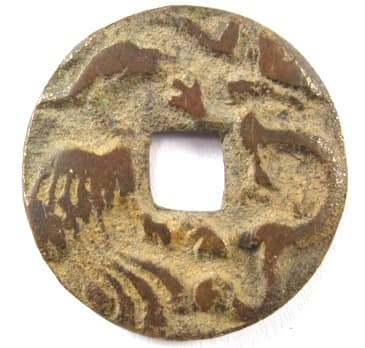
with a phoenix on the left and a
dragon on the right
(reverse side)
In this example, the phoenix is on the left and the dragon is on the right. The two are facing each other with their heads at the top of the charm.
It is a little difficult to see but the wings of the phoenix are just to the left of the square hole. The head is at the eleven o'clock position and the tail feathers are at the seven o'clock position.
The dragon is on the right with the tip of its mouth at the twelve o'clock position and a dot representing its left eye at the one o'clock position. Its left front claw is just above the square hole. The dragon's body curves down the right side of the charm and its left rear claw is just below the central hole. Its tail is almost touching the upper tail feather of the phoenix.
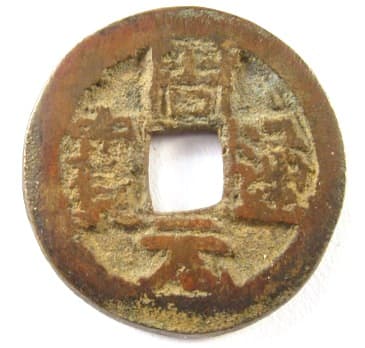
with a phoenix and dragon
(obverse side)
Like the charm above, the obverse side of this charm has the auspicious inscription zhou yuan tong bao (周元通宝).
The charm has a diameter of 25 mm and a weight of 6.6 grams.
Sex Education Marriage Charms
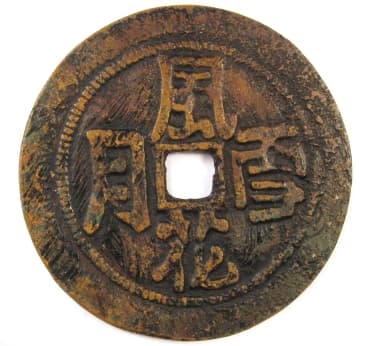
newlyweds as a form of
sex education
This charm may be from the Qing (Ch'ing) Dynasty (1644-1911 AD) or it may be a 20th Century reproduction. In any case, it is typical of the type of Chinese marriage charm that was given to newlyweds to illustrate how they should perform on their wedding night to meet their obligations to family and society to produce children.
The inscription is read top to bottom and right to left as feng hua xue yue (风花雪月) which translates as "wind, flowers, snow, moon".
The broad rim has a very ornate design.
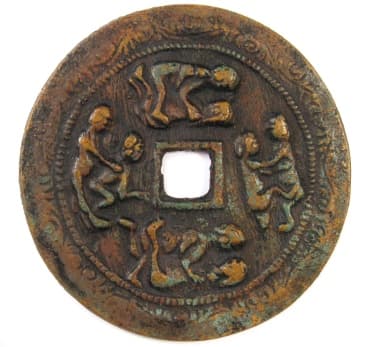
four amorous couples in
different sexual positions
The reverse side depicts four couples making love in different sexual positions.
This is a very large and heavy coin.
The diameter is approximately 64 mm.
Return to Ancient Chinese Charms and Coins
